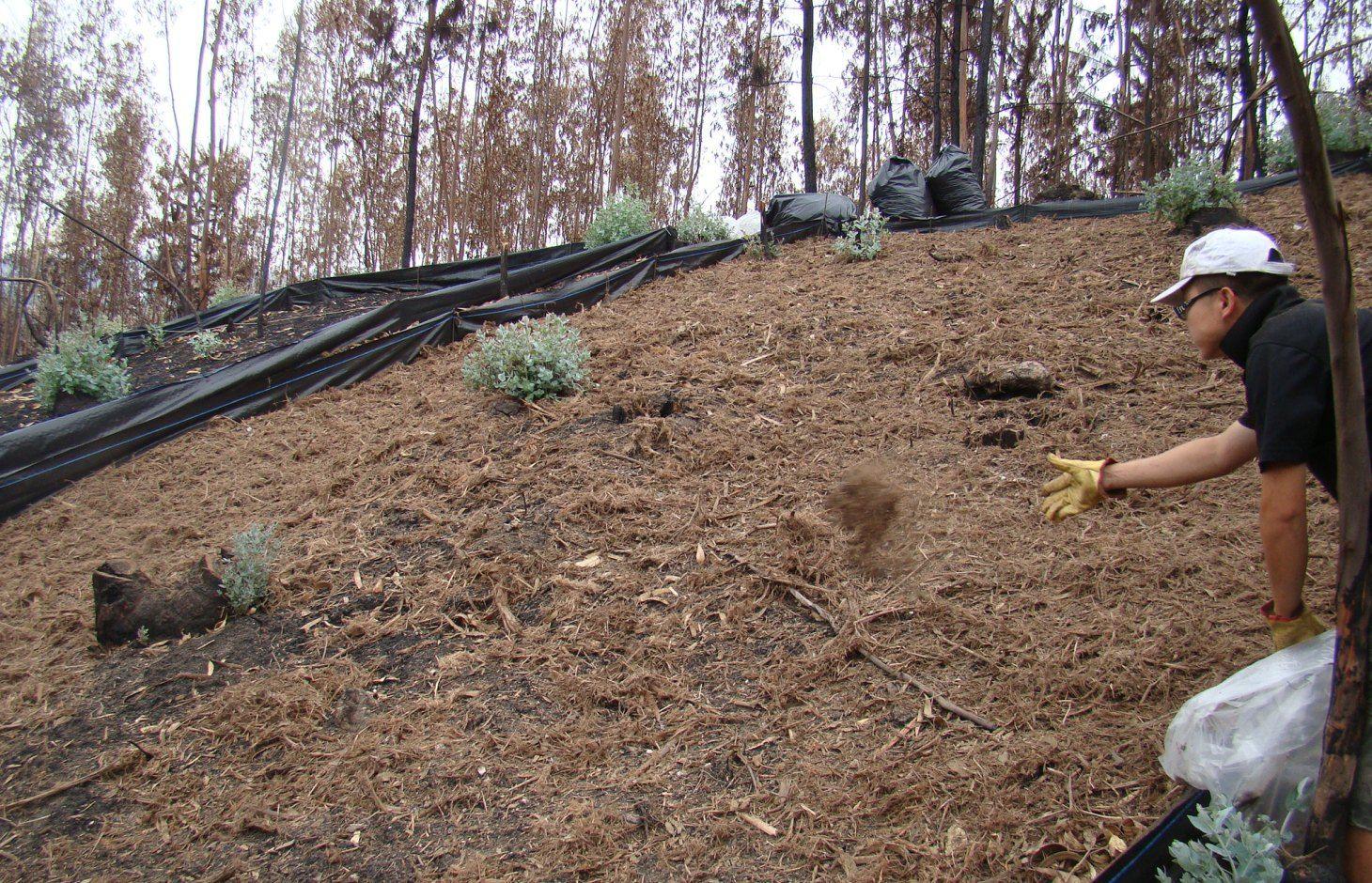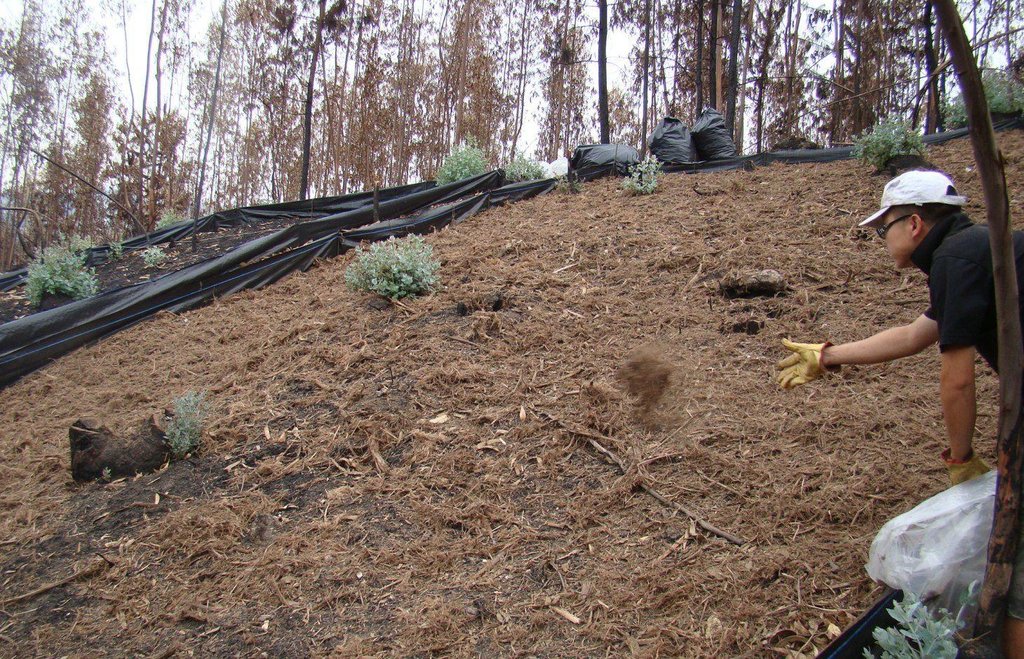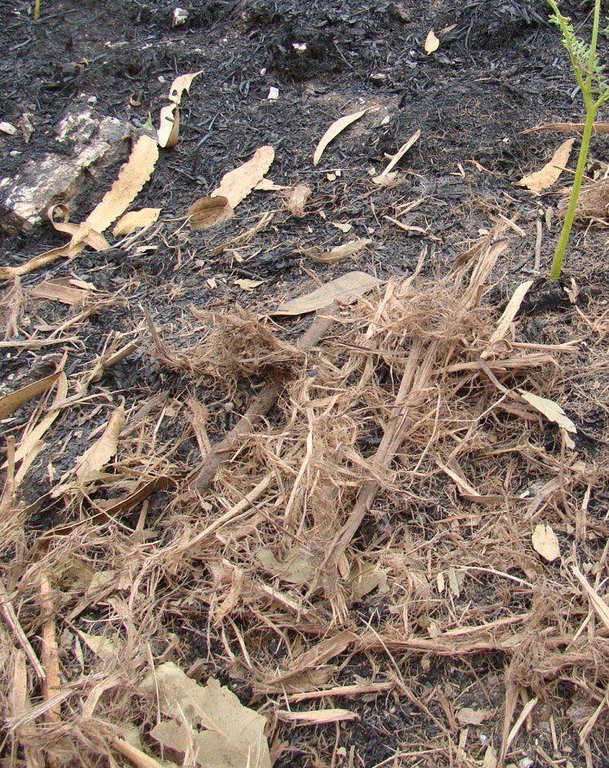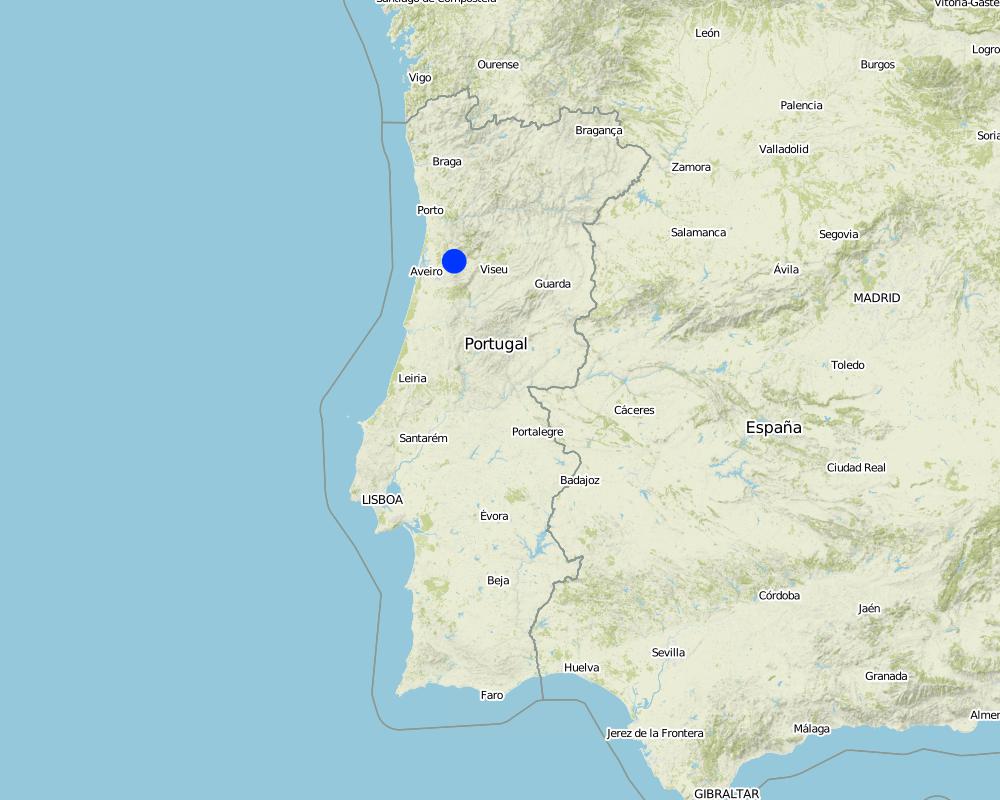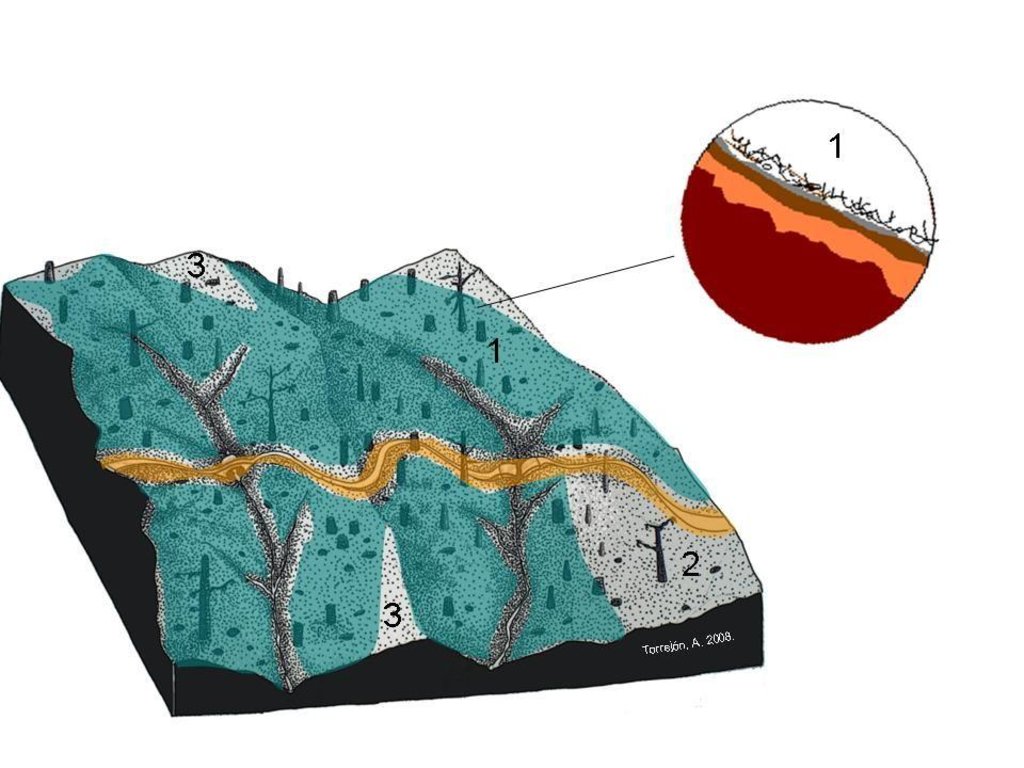Post-fire Forest Residue Mulch [โปรตุเกส]
- ผู้สร้างสรรค์:
- การอัพเดท:
- ผู้รวบรวม: Sergio Prats Alegre Prats
- ผู้เรียบเรียง: –
- ผู้ตรวจสอบ: Fabian Ottiger, Alexandra Gavilano
acolchoado, aplicação de restos vegetais
technologies_1186 - โปรตุเกส
ดูส่วนย่อย
ขยายทั้งหมด ย่อทั้งหมด1. ข้อมูลทั่วไป
1.2 รายละเอียดที่ติดต่อได้ของผู้รวบรวมและองค์กรที่เกี่ยวข้องในการประเมินและการจัดเตรียมทำเอกสารของเทคโนโลยี
ผู้เชี่ยวชาญ SLM:
Keizer Jan Jacob
Universidade de Aveiro-CESAM
โปรตุเกส
ผู้เชี่ยวชาญ SLM:
ชื่อของโครงการซึ่งอำนวยความสะดวกในการทำเอกสารหรือการประเมินเทคโนโลยี (ถ้าเกี่ยวข้อง)
Preventing and Remediating degradation of soils in Europe through Land Care (EU-RECARE )ชื่อของโครงการซึ่งอำนวยความสะดวกในการทำเอกสารหรือการประเมินเทคโนโลยี (ถ้าเกี่ยวข้อง)
Catastrophic shifts in drylands (EU-CASCADE)ชื่อขององค์กรซึ่งอำนวยความสะดวกในการทำเอกสารหรือการประเมินเทคโนโลยี (ถ้าเกี่ยวข้อง)
University of Aveiro (University of Aveiro) - โปรตุเกส1.3 เงื่อนไขการใช้ข้อมูลที่ได้บันทึกผ่านทาง WOCAT
ผู้รวบรวมและวิทยากรหลักยอมรับเงื่อนไขเกี่ยวกับการใช้ข้อมูลที่ถูกบันทึกผ่านทาง WOCAT:
ใช่
2. การอธิบายลักษณะของเทคโนโลยี SLM
2.1 การอธิบายแบบสั้น ๆ ของเทคโนโลยี
คำจำกัดความของเทคโนโลยี:
Forest residue mulch is spread immediately after a wildfire in order to prevent soil erosion and reduce overland flow.
2.2 การอธิบายแบบละเอียดของเทคโนโลยี
คำอธิบาย:
In two areas of eucalypt plantations affected by wildfires in central Portugal in 2007 and 2010, the research team of the University of Aveiro set up two experiments in order to test the effect of forest residue mulching as a soil erosion mitigation technique. Forest residues such as chopped eucalypt bark mulch was spread over a group of erosion plots, and was compared to an untreated group of plots.
The mulching was applied at ratios of 8.7 and 10.8 Mg ha-1 provided an initial ground cover of 70 to 80%, and was found to reduce post-fire runoff by 40-50% and soil erosion by 85-90%, respectively.
Purpose of the Technology: The increase in ground cover will decrease post-fire soil erosion by reducing raindrop impact over the ashes and bare soil, and decrease the runoff amount by increasing water surface storage, decreasing runoff velocity, and increase infiltration.
Ideally, post-fire mulching must be carried out immediately after the fire, in order to prevent that the first autumn rainfall events fall over the bare and unprotected burnt soils. It is intended for places in which burnt severity was moderate to high and where there are important values at risk, such as water reservoirs, populations, industries, human and wild life.
Establishment / maintenance activities and inputs: The chopped bark mulch was obtained at a depot 20 km from the burnt area, where eucalypt logs are debarked and then transported to a paper pulp factory. The bark is chopped into fibers and are typically transported to a biomass energy plant. We used these 10–15 cm wide 2–5 cm long bark fibers as the source for our mulching experiment. The chopped bark mulch decays very slowly (around 20% less ground cover per year) which was very useful in cases of low re-growth of natural vegetation.
Natural / human environment: The eucalypt trees in the region are typically planted as monocultures for paper pulp production, and harvested every 7-14 years. The landscape reflects a long history of intense land management, with a mosaic of (semi-)natural and man-made agricultural and afforested lands. Since the 1980´s, however, wildfires have increased dramatically in frequency and extent, aided by a general warming and drying trend but driven primarily by socio-economic changes.
2.3 รูปภาพของเทคโนโลยี
2.5 ประเทศภูมิภาค หรือสถานที่ตั้งที่เทคโนโลยีได้นำไปใช้และได้รับการครอบคลุมโดยการประเมินนี้
ประเทศ:
โปรตุเกส
ภูมิภาค/รัฐ/จังหวัด:
Portugal/Beira Litoral
ข้อมูลจำเพาะเพิ่มเติมของสถานที่ตั้ง :
Sever do vouga/ Pessegueiro do Vouga, Ermida
ระบุการกระจายตัวของเทคโนโลยี:
- กระจายไปอย่างสม่ำเสมอในพื้นที่
If precise area is not known, indicate approximate area covered:
- < 0.1 ตร.กม.(10 เฮกตาร์)
แสดงความคิดเห็น:
Total area covered by the SLM Technology is 1.0E-5 m2.
The experiment was carried out in grous of small bounded plots of 0.25, 16 and 100 m2.
Map
×2.6 วันที่การดำเนินการ
ถ้าไม่รู้ปีที่แน่นอน ให้ระบุวันที่โดยประมาณ:
- น้อยกว่า 10 ปี (ไม่นานนี้)
2.7 คำแนะนำของเทคโนโลยี
ให้ระบุว่าเทคโนโลยีถูกแนะนำเข้ามาอย่างไร:
- ในช่วงการทดลองหรือการทำวิจัย
ความคิดเห็น (ประเภทของโครงการ เป็นต้น) :
The first experiment was carried out in 2007.
3. การจัดประเภทของเทคโนโลยี SLM
3.2 ประเภทของการใช้ที่ดินในปัจจุบันที่ได้นำเทคโนโลยีไปใช้

ป่า/พื้นที่ทำไม้
- ป่า/พื้นที่ทำไม้
Type of tree:
- Eucalyptus species
ผลิตภัณฑ์และบริการ:
- ไม้ซุง
- ไม้ที่นำมาทำเป็นเชื้อเพลิง
แสดงความคิดเห็น:
Major land use problems (compiler’s opinion): Increased runoff and soil erosion, resulting in a decrease of on-site fertility and derived off-site effects such as loss of water quality, reservoirs water volume storage, higher risk of flooding and human beings damage.
Major land use problems (land users’ perception): Loss of wood resources and productivity.
Plantation forestry: eucalypt are logged and left to regrow from stumps each 7-10 years
Forest products and services: timber, fuelwood
Number of growing seasons per year: 1
3.5 กลุ่ม SLM ที่ตรงกับเทคโนโลยีนี้
- การปรับปรุงดิน / พืชคลุมดิน
3.6 มาตรการ SLM ที่ประกอบกันเป็นเทคโนโลยี

มาตรการจัดการพืช
- A1: พืช/สิ่งปกคลุมดิน
แสดงความคิดเห็น:
Main measures: agronomic measures
Type of agronomic measures: mulching
3.7 รูปแบบหลักของการเสื่อมโทรมของที่ดินที่ได้รับการแก้ไขโดยเทคโนโลยี

การกัดกร่อนของดินโดยน้ำ
- Wt (Loss of topsoil): การสูญเสียดินชั้นบนหรือการกัดกร่อนที่ผิวดิน
- Wo (Offsite degradation): ผลกระทบนอกพื้นที่

การเสื่อมโทรมของดินทางด้านเคมี
- Cn (Fertility decline): ความอุดมสมบูรณ์และปริมาณอินทรียวัตถุในดินถูกทำให้ลดลงไป (ไม่ได้เกิดจากสาเหตุการกัดกร่อน)

การเสื่อมโทรมของน้ำ
- Hs (Change in quantity of surface water): การเปลี่ยนแปลงปริมาณของน้ำที่ผิวดิน
- Hp (Decline of surface water quality): การลดลงของคุณภาพน้ำที่ผิวดิน
แสดงความคิดเห็น:
Main type of degradation addressed: Wt: loss of topsoil / surface erosion, Hs: change in quantity of surface water, Hp: decline of surface water quality
Secondary types of degradation addressed: Wo: offsite degradation effects, Cn: fertility decline and reduced organic matter content
Main causes of degradation: crop management (annual, perennial, tree/shrub) (Eucalypt monocultures are prone to suffer wildfires), deforestation / removal of natural vegetation (incl. forest fires), disturbance of water cycle (infiltration / runoff) (Increased runoff is observed after wildfires), Heavy / extreme rainfall (intensity/amounts) (Burnt areas are very sensitive to high intensity events), other natural causes (avalanches, volcanic eruptions, mud flows, highly susceptible natural resources, extreme topography, etc.) specify (Sediment deposition can decrease the storage volume of reservoirs.)
Secondary causes of degradation: floods (Overland flow can be extremely high after forest fires), inputs and infrastructure: (roads, markets, distribution of water points, other, …) (Roads concentrated the runoff and are greatly degraded.)
3.8 การป้องกัน การลดลง หรือการฟื้นฟูความเสื่อมโทรมของที่ดิน
ระบุเป้าหมายของเทคโนโลยีกับความเสื่อมโทรมของที่ดิน:
- ป้องกันความเสื่อมโทรมของที่ดิน
- ลดความเสื่อมโทรมของดิน
แสดงความคิดเห็น:
Main goals: prevention of land degradation, mitigation / reduction of land degradation
4. ข้อมูลจำเพาะด้านเทคนิค กิจกรรมการนำไปปฏิบัติใช้ ปัจจัยนำเข้า และค่าใช้จ่าย
4.1 แบบแปลนทางเทคนิคของเทคโนโลยี
ข้อมูลจำเพาะด้านเทคนิค (แบบแปลนทางเทคนิคของเทคโนโลยี):
Forest residue mulch is spread as homogeneous as possible over steep areas (steeper than 15º) burnt at high fire severity (represented in green and 1). Other areas which are flat (2) and burnt at low severity or only partially burnt (3) must be avoided.
Location: Ermida. Sever do Vouga/ Portugal
Date: 15 9 2010
Technical knowledge required for field staff / advisors: low (forest residue mulching is highly effective in all situations, but applications using short fibres mulching as well as low intensity burning should be avoided.)
Technical knowledge required for land users: low
Main technical functions: control of raindrop splash, control of dispersed runoff: retain / trap, control of concentrated runoff: retain / trap, control of concentrated runoff: impede / retard, control of concentrated runoff: drain / divert, improvement of ground cover, improvement of water quality, buffering / filtering water, sediment retention / trapping, sediment harvesting
Secondary technical functions: control of dispersed runoff: impede / retard, reduction of slope angle, increase of surface roughness, increase in organic matter, increase of infiltration, increase / maintain water stored in soil, increase of groundwater level / recharge of groundwater
Mulching
Material/ species: chopped bark, cork, stems, leaves, straw/eucalypt, pine, oaks, shrubs
Quantity/ density: 2-10t/ha
Remarks: material with low density (straw) need less weight for achieving the final goal: 70% ground cover.
ผู้เขียน:
Departamento de Ambiente e Ordenamento. Universidade de Aveiro.
4.2 ข้อมูลทั่วไปเกี่ยวกับการคำนวณปัจจัยนำเข้าและค่าใช้จ่าย
อื่นๆ หรือสกุลเงินประจำชาติ (ระบุ):
Euro
If relevant, indicate exchange rate from USD to local currency (e.g. 1 USD = 79.9 Brazilian Real): 1 USD =:
0.78
ระบุค่าเฉลี่ยของค่าจ้างในการจ้างแรงงานต่อวัน:
64.00
4.3 กิจกรรมเพื่อการจัดตั้ง
| กิจกรรม | Timing (season) | |
|---|---|---|
| 1. | Labour | |
| 2. | Transportation (small truck for carrying persons and material) | |
| 3. | Eucalypt chopped bark mulch | |
| 4. | Others |
4.4 ค่าใช้จ่ายของปัจจัยนำเข้าที่จำเป็นสำหรับการจัดตั้ง
| ปัจจัยนำเข้า | หน่วย | ปริมาณ | ค่าใช้จ่ายต่อหน่วย | ค่าใช้จ่ายทั้งหมดต่อปัจจัยนำเข้า | %ของค่าใช้จ่ายที่ก่อให้เกิดขึ้นโดยผู้ใช้ที่ดิน | |
|---|---|---|---|---|---|---|
| แรงงาน | Labour | ha | 1.0 | 192.0 | 192.0 | 100.0 |
| อุปกรณ์ | Machine use | ha | 1.0 | 51.2 | 51.2 | 100.0 |
| อื่น ๆ | Forest residue mulch | ha | 1.0 | 307.6 | 307.6 | 100.0 |
| อื่น ๆ | Others | ha | 1.0 | 64.1 | 64.1 | 100.0 |
| ค่าใช้จ่ายทั้งหมดของการจัดตั้งเทคโนโลยี | 614.9 | |||||
| Total costs for establishment of the Technology in USD | 788.33 | |||||
แสดงความคิดเห็น:
Duration of establishment phase: 1 month(s)
4.6 ค่าใช้จ่ายของปัจจัยนำเข้าและกิจกรรมที่เกิดขึ้นเป็นประจำที่ต้องการการบำรุงรักษา (ต่อปี)
แสดงความคิดเห็น:
The prices were determined in winter 2012 for central Portugal. It is intended that mulch is applied only once, and thus maintenance is not needed. In other regions other forest residues can have a higher availability. Straw, needles, deciduous leaves or chopped shrubs are lighter compared to eucalypt chopped bark, slash stems or wood chips, and thus, can be easier to apply and transport. However, the lighter the material, the easier it can be blown away in windy areas.
4.7 ปัจจัยสำคัญที่สุดที่มีผลกระทบต่อค่าใช้จ่าย
ปัจจัยสำคัญที่สุดที่มีผลกระทบต่อค่าใช้จ่ายต่างๆ:
Accessibility and steepness will raise the costs, but selecting forest residues with lower densities as well as applying them in horizontal strips along the slope can reduce the application rates and the costs.
For large and inaccessible areas some researchers indicated that helicopters can reduce the costs.
5. สิ่งแวดล้อมทางธรรมชาติและของมนุษย์
5.1 ภูมิอากาศ
ฝนประจำปี
- < 250 ม.ม.
- 251-500 ม.ม.
- 501-750 ม.ม.
- 751-1,000 ม.ม.
- 1,001-1,500 ม.ม.
- 1,501-2,000 ม.ม.
- 2,001-3,000 ม.ม.
- 3,001-4,000 ม.ม.
- > 4,000 ม.ม.
เขตภูมิอากาศเกษตร
- ชื้น
- กึ่งชุ่มชื้น
Thermal climate class: subtropics
Thermal climate class: temperate
5.2 สภาพภูมิประเทศ
ค่าเฉลี่ยความลาดชัน:
- ราบเรียบ (0-2%)
- ลาดที่ไม่ชัน (3-5%)
- ปานกลาง (6-10%)
- เป็นลูกคลื่น (11-15%)
- เป็นเนิน (16-30%)
- ชัน (31-60%)
- ชันมาก (>60%)
ธรณีสัณฐาน:
- ที่ราบสูง/ที่ราบ
- สันเขา
- ไหล่เขา
- ไหล่เนินเขา
- ตีนเนิน
- หุบเขา
ระดับความสูง:
- 0-100 เมตร
- 101-500 เมตร
- 501-1,000 เมตร
- 1,001-1,500 เมตร
- 1,501-2,000 เมตร
- 2,001-2,500 เมตร
- 2,501-3,000 เมตร
- 3,001-4,000 เมตร
- > 4,000 เมตร
ความคิดเห็นและข้อมูลจำเพาะเพิ่มเติมเรื่องสภาพภูมิประเทศ:
Altitudinal zone: 101-500 m a.s.l. (300m)
5.3 ดิน
ค่าเฉลี่ยความลึกของดิน:
- ตื้นมาก (0-20 ซ.ม.)
- ตื้น (21-50 ซ.ม.)
- ลึกปานกลาง (51-80 ซ.ม.)
- ลึก (81-120 ซ.ม.)
- ลึกมาก (>120 ซ.ม.)
เนื้อดิน (ดินชั้นบน):
- หยาบ/เบา (ดินทราย)
- ปานกลาง (ดินร่วน ทรายแป้ง)
อินทรียวัตถุในดิน:
- สูง (>3%)
(ถ้ามี) ให้แนบคำอธิบายเรื่องดินแบบเต็มหรือระบุข้อมูลที่มีอยู่ เช่น ชนิดของดิน ค่า pH ของดินหรือความเป็นกรดของดิน ความสามารถในการแลกเปลี่ยนประจุบวก ไนโตรเจน ความเค็ม เป็นต้น:
Topsoil organic matter is high (Around 10 % between 0 to 5 cm of soil depth)
Soil fertility is high-medium
Soil drainage/infiltration is medium (Dependent on the soil water repellence cycles, characteristics of eucalypt and pine plantations on the area.)
Soil water storage capacity is medium
5.4 ความเป็นประโยชน์และคุณภาพของน้ำ
ระดับน้ำใต้ดิน:
5-50 เมตร
น้ำไหลบ่าที่ผิวดิน:
ดี
คุณภาพน้ำ (ที่ยังไม่ได้บำบัด):
เป็นน้ำเพื่อการดื่มที่ดี
5.5 ความหลากหลายทางชีวภาพ
ความหลากหลายทางชนิดพันธุ์:
- ปานกลาง
5.6 ลักษณะของผู้ใช้ที่ดินที่นำเทคโนโลยีไปปฏิบัติใช้
แนวทางการตลาดของระบบการผลิต:
- mixed (subsistence/ commercial)
- ทำการค้า/การตลาด
รายได้ที่มาจากนอกฟาร์ม:
- < 10% ของรายได้ทั้งหมด
ระดับของความมั่งคั่งโดยเปรียบเทียบ:
- จน
- พอมีพอกิน
เป็นรายบุคคล/ครัวเรือน:
- ลูกจ้าง (บริษัท รัฐบาล)
เพศ:
- หญิง
- ชาย
ระบุลักษณะอื่นๆที่เกี่ยวข้องของผู้ใช้ที่ดิน:
Land users applying the Technology are mainly common / average land users
Population density: 50-100 persons/km2
Annual population growth: negative
50% of the land users are average wealthy.
40% of the land users are poor.
10% of the land users are poor.
5.7 Average area of land used by land users applying the Technology
- < 0.5 เฮกตาร์
- 0.5-1 เฮกตาร์
- 1-2 เฮกตาร์
- 2-5 เฮกตาร์
- 5-15 เฮกตาร์
- 15-50 เฮกตาร์
- 50-100 เฮกตาร์
- 100-500 เฮกตาร์
- 500-1,000 เฮกตาร์
- 1,000-10,000 เฮกตาร์
- >10,000 เฮกตาร์
พิจารณาว่าเป็นขนาดเล็ก กลาง หรือขนาดใหญ่ (ซึ่งอ้างอิงถึงบริบทระดับท้องถิ่น):
- ขนาดเล็ก
5.8 กรรมสิทธิ์ในที่ดิน สิทธิในการใช้ที่ดินและสิทธิในการใช้น้ำ
กรรมสิทธิ์ในที่ดิน:
- เป็นแบบชุมชนหรือหมู่บ้าน
สิทธิในการใช้ที่ดิน:
- เกี่ยวกับชุมชน (ถูกจัดระเบียบ)
- รายบุคคล
สิทธิในการใช้น้ำ:
- เข้าถึงได้แบบเปิด (ไม่ได้จัดระเบียบ)
5.9 การเข้าถึงบริการและโครงสร้างพื้นฐาน
สุขภาพ:
- จน
- ปานกลาง
- ดี
การศึกษา:
- จน
- ปานกลาง
- ดี
ความช่วยเหลือทางด้านเทคนิค:
- จน
- ปานกลาง
- ดี
การจ้างงาน (เช่น ภายนอกฟาร์ม):
- จน
- ปานกลาง
- ดี
ตลาด:
- จน
- ปานกลาง
- ดี
พลังงาน:
- จน
- ปานกลาง
- ดี
ถนนและการขนส่ง:
- จน
- ปานกลาง
- ดี
น้ำดื่มและการสุขาภิบาล:
- จน
- ปานกลาง
- ดี
บริการด้านการเงิน:
- จน
- ปานกลาง
- ดี
6. ผลกระทบและสรุปคำบอกกล่าว
6.1 ผลกระทบในพื้นที่ดำเนินการ (On-site) จากการใช้เทคโนโลยี
ผลกระทบทางด้านเศรษฐกิจและสังคม
ความเป็นประโยชน์และคุณภาพของน้ำ
การมีน้ำไว้ให้ปศุสัตว์
การมีน้ำไว้ให้สำหรับการชลประทาน
ความต้องการน้ำจากการชลประทาน
รายได้และค่าใช้จ่าย
ค่าใช่จ่ายของปัจจัยการผลิตทางการเกษตร
แสดงความคิดเห็น/ระบุ:
Eucalypt chopped bark mulch increases expenses if not funded by the Government
ผลกระทบด้านสังคมวัฒนธรรมอื่น ๆ
SLM หรือความรู้เรื่องความเสื่อมโทรมของที่ดิน
การบรรเทาความขัดแย้ง
แสดงความคิดเห็น/ระบุ:
Less damage to off-site neighbouring properties
Improved livelihoods and human well-being
แสดงความคิดเห็น/ระบุ:
Public awareness of the technology is very limited. It is necessary to show it to landowners and stakeholders and increase dissemination.
ผลกระทบด้านนิเวศวิทยา
วัฐจักรน้ำหรือน้ำบ่า
คุณภาพน้ำ
น้ำไหลบ่าที่ผิวดิน
น้ำบาดาลหรือระดับน้ำในแอ่งน้ำบาดาล
การระเหย
ดิน
ความชื้นในดิน
สิ่งปกคลุมดิน
การสูญเสียดิน
อินทรียวัตถุในดิน/ต่ำกว่าดินชั้น C
ความหลากหลายทางชีวภาพของพืชและสัตว์
ความหลากหลายทางชีวภาพของสัตว์
ชนิดพันธุ์ที่ให้ประโยชน์
ผลกระทบด้านนิเวศวิทยาอื่น ๆ
Hazard towards adverse events
6.2 ผลกระทบนอกพื้นที่ดำเนินการ (Off-site) จากการใช้เทคโนโลยี
น้ำที่ใช้ประโยชน์ได้
น้ำท่วมพื้นที่ท้ายน้ำ
การทับถมของดินตะกอนพื้นที่ท้ายน้ำ
แสดงความคิดเห็น/ระบุ:
If applied in large areas
การเกิดมลพิษในน้ำบาดาลหรือแม่น้ำ
ความสามารถต้านทานการเปลี่ยนแปลง / ความสามารถในการคัดกรอง
ตะกอนที่ถูกพัดพามาโดยลม
ความเสียหายต่อพื้นที่เพาะปลูกของเพื่อนบ้าน
ความเสียหายต่อโครงสร้างพื้นฐานของรัฐหรือของเอกชน
แสดงความคิดเห็น/ระบุ:
If applied in large areas upslope
6.3 การเผชิญและความตอบสนองของเทคโนโลยีต่อการเปลี่ยนแปลงสภาพภูมิอากาศที่ค่อยเป็นค่อยไป และสภาพรุนแรงของภูมิอากาศ / ภัยพิบัติ (ที่รับรู้ได้โดยผู้ใช้ที่ดิน)
การเปลี่ยนแปลงสภาพภูมิอากาศที่ค่อยเป็นค่อยไป
การเปลี่ยนแปลงสภาพภูมิอากาศที่ค่อยเป็นค่อยไป
| ฤดู | increase or decrease | เทคโนโลยีมีวิธีการรับมืออย่างไร | |
|---|---|---|---|
| อุณหภูมิประจำปี | เพิ่มขึ้น | ดี |
สภาพรุนแรงของภูมิอากาศ (ภัยพิบัติ)
ภัยพิบัติทางอุตุนิยมวิทยา
| เทคโนโลยีมีวิธีการรับมืออย่างไร | |
|---|---|
| พายุฝนประจำท้องถิ่น | ดี |
| พายุลมประจำท้องถิ่น | ดี |
ภัยพิบัติจากสภาพภูมิอากาศ
| เทคโนโลยีมีวิธีการรับมืออย่างไร | |
|---|---|
| ภัยจากฝนแล้ง | ดี |
ภัยพิบัติจากน้ำ
| เทคโนโลยีมีวิธีการรับมืออย่างไร | |
|---|---|
| น้ำท่วมตามปกติ (แม่น้ำ) | ไม่ค่อยดี |
ผลลัพธ์ตามมาที่เกี่ยวข้องกับภูมิอากาศอื่น ๆ
ผลลัพธ์ตามมาที่เกี่ยวข้องกับภูมิอากาศอื่น ๆ
| เทคโนโลยีมีวิธีการรับมืออย่างไร | |
|---|---|
| ช่วงการปลูกพืชที่ลดลงมา | ไม่ทราบ |
6.4 การวิเคราะห์ค่าใช้จ่ายและผลประโยชน์ที่ได้รับ
ผลประโยชน์ที่ได้รับเปรียบเทียบกับค่าใช้จ่ายในการจัดตั้งเป็นอย่างไร (จากมุมมองของผู้ใช้ที่ดิน)
ผลตอบแทนระยะสั้น:
ด้านบวก
ผลตอบแทนระยะยาว:
เป็นกลางหรือสมดุล
ผลประโยชน์ที่ได้รับเปรียบเทียบกับค่าใช้จ่ายในการบำรุงรักษาหรือต้นทุนที่เกิดขึ้นซ้ำอีก เป็นอย่างไร (จากมุมมองของผู้ใช้ที่ดิน)
ผลตอบแทนระยะสั้น:
ด้านบวกเล็กน้อย
ผลตอบแทนระยะยาว:
ด้านบวกเล็กน้อย
6.5 การปรับตัวของเทคโนโลยี
แสดงความคิดเห็น:
Comments on acceptance with external material support: The technology has been tested by scientific researchers and it is very effective, but not broadly implemented.
Comments on spontaneous adoption: The technology has been tested by scientific researchers researchers and it is very effective, but not broadly implemented.
There is no trend towards spontaneous adoption of the Technology
6.7 จุดแข็ง / ข้อได้เปรียบ / โอกาสของเทคโนโลยี
| จุดแข็ง / ข้อได้เปรียบ / โอกาสในทัศนคติของผู้ใช้ที่ดิน |
|---|
| It will prevent sediment movement and accumulation over roads and downslope properties |
| จุดแข็ง / ข้อได้เปรียบ / โอกาสในทัศนคติของผู้รวบรวมหรือวิทยากรหลัก |
|---|
|
It is a technology very easy to apply, with low failure possibilities and a strong soil erosion control How can they be sustained / enhanced? Some researchers found better performance by grinding the mulch and selecting only the longest fibres. |
| The material is readily available (residues from the main forest specie affected by the wildfire) |
6.8 จุดอ่อน / ข้อเสียเปรียบ / ความเสี่ยงของเทคโนโลยีและวิธีการแก้ไข
| จุดอ่อน / ข้อเสียเปรียบ / ความเสี่ยงในทัศนคติของผู้ใช้ที่ดิน | มีวิธีการแก้ไขได้อย่างไร |
|---|---|
| The costs are not very high, but enough to discourage the landowners to cover the expenses. | Look for Government funding, educate land owners about soil erosion conservation techniques. |
| จุดอ่อน / ข้อเสียเปรียบ / ความเสี่ยงในทัศนคติของผู้รวบรวมหรือวิทยากรหลัก | มีวิธีการแก้ไขได้อย่างไร |
|---|---|
| When applying high density mulches the application labour requirements and costs will be higher | Distribute the mulch in strips, use lighter mulches, grind to remove the fine fibres or maybe try to reduce the application rate. It is also possible to use in-situ chopping tree machines or to use aerial application methods, such as helicopters to reduce the application costs. |
7. การอ้างอิงและการเชื่อมต่อ
7.1 วิธีการและแหล่งข้อมูล
7.2 การอ้างอิงถึงสิ่งตีพิมพ์
หัวข้อ, ผู้เขียน, ปี, หมายเลข ISBN:
Prats S. A., Macdonald L.H., Monteiro M.S.V., Ferreira A.J.D., Coelho C.O.A., Keizer J.J.,2012. Effectiveness of forest residue mulching in reducing post-fire runoff and erosionin a pine and a eucalypt plantation in north-central Portugal. Geoderma 191, 115-124.
ชื่อเรื่อง ผู้เขียน ปี ISBN:
Internet
หัวข้อ, ผู้เขียน, ปี, หมายเลข ISBN:
Shakesby R.A., Boakes D.J., Coelho C.O.A., Gonçalves A.J.B., Walsh R.P.D., 1996. Limitingthe soil degradational impacts of wildfire in pine and eucalyptus forests in Portugal.Applied Geography 16, 337-335.
ชื่อเรื่อง ผู้เขียน ปี ISBN:
Internet
หัวข้อ, ผู้เขียน, ปี, หมายเลข ISBN:
Robichaud, P.R., Lewis, S.A., Ashmun, L.E., Wagenbrenner, J.W., Brown, R.E., 2013a.Postfire mulching for runoff and erosion mitigation Part I: Effectiveness at reducinghillslope erosion rates. Catena 105, 75–92.
ชื่อเรื่อง ผู้เขียน ปี ISBN:
Internet
ลิงก์และโมดูล
ขยายทั้งหมด ย่อทั้งหมดลิงก์
ไม่มีลิงก์
โมดูล
ไม่มีโมดูล


